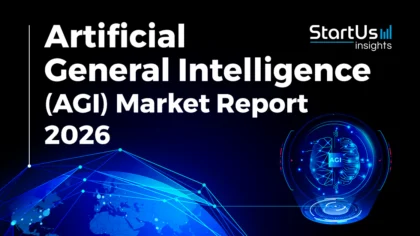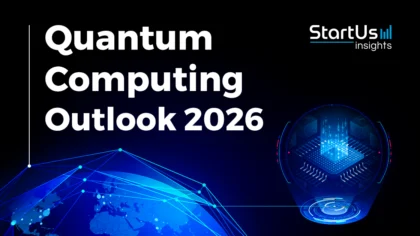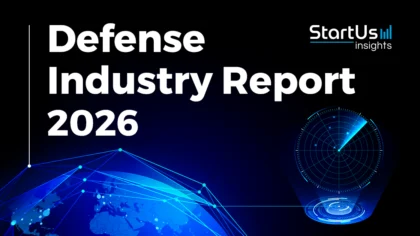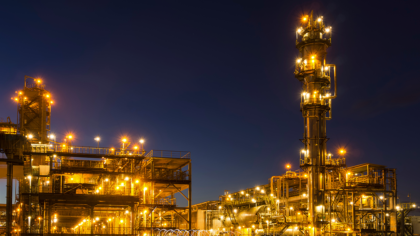Accelerate Productivity in 2025
Reignite Growth Despite the Global Slowdown
The asset management landscape is rapidly evolving as industries face increasing pressure to optimize physical assets, extend their lifespan, and reduce operational risks. In 2025, asset management trends like artificial intelligence (AI), predictive maintenance, and asset analytics are reshaping how organizations manage infrastructure and equipment.
Risk management, compliance, and cybersecurity are becoming core pillars. Innovations like remote asset monitoring, advanced robotics, and asset lifecycle management improve visibility, reliability, and control. As these trends gain momentum, they redefine operational strategies across sectors – from manufacturing to utilities.
What are the Top 10 Asset Management Trends in 2025?
- AI-powered Asset Management
- Asset Tracking & Condition Monitoring
- Risk Management
- Asset Management Compliance
- Asset Analytics
- Cybersecurity
- Asset Lifecycle Management
- Remote Asset Management (RAM)
- Predictive & Preventive Maintenance
- Advanced Robotics
Methodology: How We Created the Asset Management Trend Report
For our trend reports, we leverage our proprietary StartUs Insights Discovery Platform, covering 7M+ global startups, 20K technologies & trends, plus 150M+ patents, news articles, and market reports.
Creating a report involves approximately 40 hours of analysis. We evaluate our own startup data and complement these insights with external research, including industry reports, news articles, and market analyses. This process enables us to identify the most impactful and innovative trends in the asset management industry.
For each trend, we select two exemplary startups that meet the following criteria:
- Relevance: Their product, technology, or solution aligns with the trend.
- Founding Year: Established between 2020 and 2025.
- Company Size: A maximum of 200 employees.
- Location: Specific geographic considerations.
This approach ensures our reports provide reliable, actionable insights into the industrial asset management innovation ecosystem while highlighting startups driving technological advancements in the industry.
Innovation Map outlines the Top 10 Asset Management Trends & 20 Promising Startups
For this in-depth research on the Top Asset Management Trends & Startups, we analyzed a sample of 6693 global startups & scaleups. The Industrial Asset Management Innovation Map created from this data-driven research helps you improve strategic decision-making by giving you a comprehensive overview of the asset management industry trends & startups that impact your company.
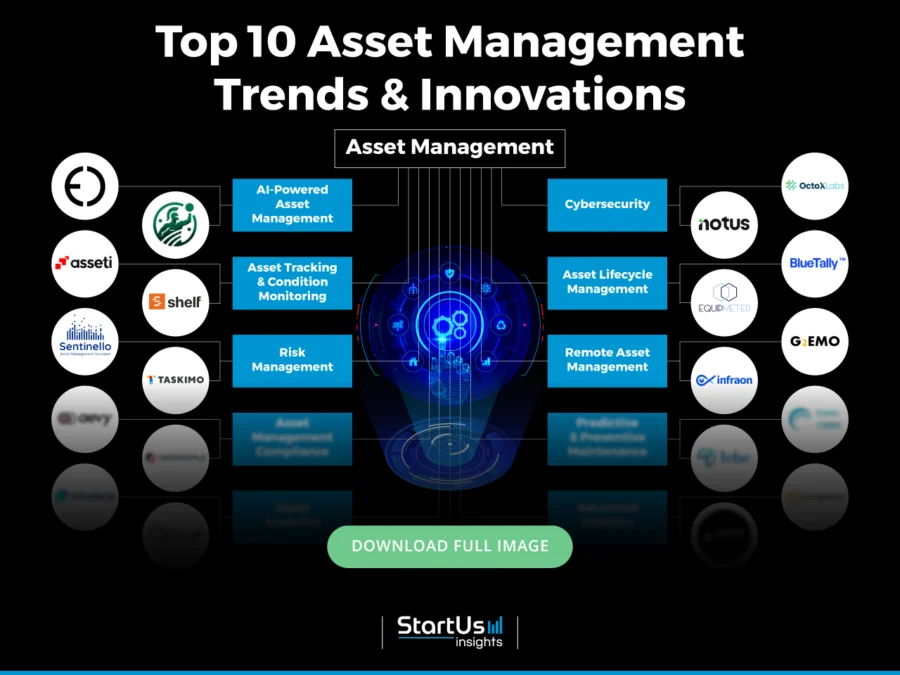
Tree Map reveals the Impact of the Top 10 Trends in Asset Management
Asset management is undergoing a major shift as AI-powered asset management and compliance solutions drive real-time decision-making and regulatory alignment. Meanwhile, asset lifecycle management, advanced robotics, and cybersecurity strengthen operational efficiency, extend equipment life, and reduce risks.
Predictive and preventive maintenance also improve uptime, cost control, and safety, while remote asset management supports monitoring and decentralized control. These innovations align with the market’s transition to a data-driven, automated asset ecosystem.
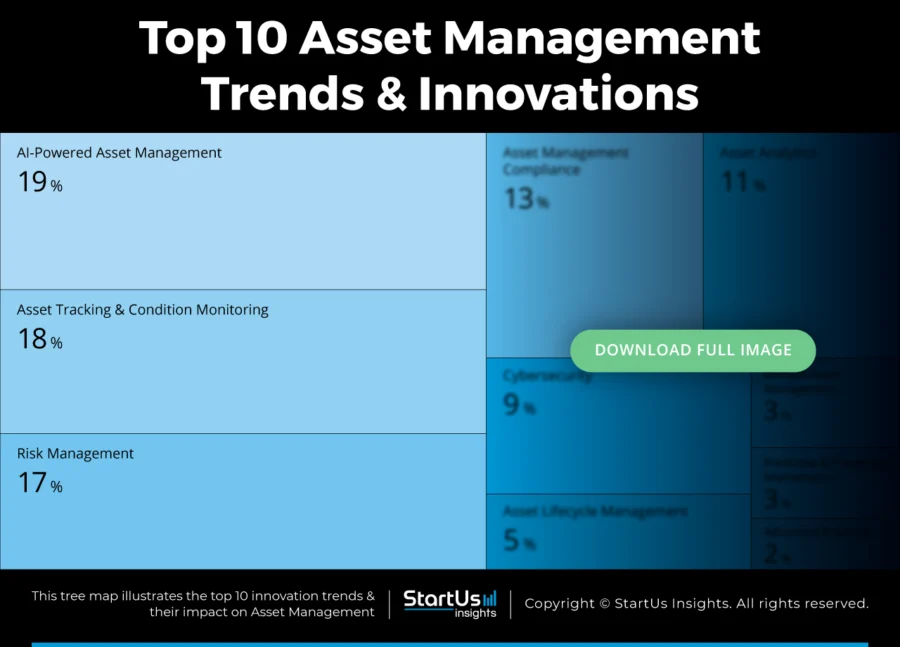
Global Startup Heat Map covers 6693 Asset Management Startups & Scaleups
The Global Startup Heat Map showcases the distribution of 6693 exemplary startups and scaleups analyzed using the StartUs Insights Discovery Platform. It highlights high startup activity in the US and India, followed by the UK and Australia. From these, 20 promising startups are featured below, selected based on factors like founding year, location, and funding.
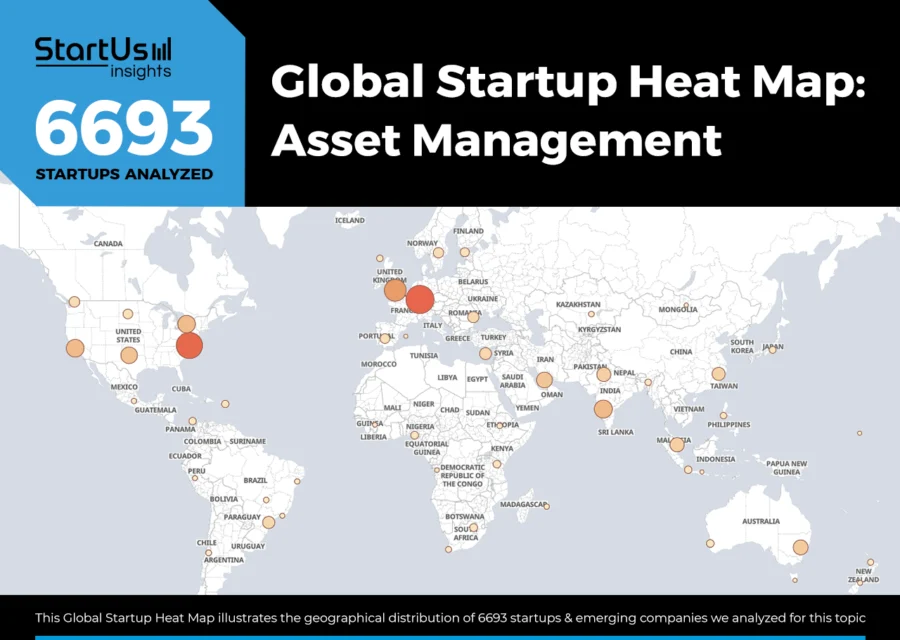
Want to Explore Asset Management Innovations & Trends?
Top 10 Emerging Asset Management Technology Trends & Innovations [2025 and Beyond]
1. AI-powered Asset Management
AI-enabled IoT sensors continuously track asset conditions such as temperature and vibration. They provide businesses with real-time insights into performance and health. This constant monitoring detects anomalies immediately and allows timely intervention and efficient asset use.
Moreover, the technology automates time-consuming tasks like data entry, asset onboarding, audits, and inventory management. It utilizes image recognition and optical character recognition (OCR) to let staff capture asset details by simply taking a photo. This eliminates manual errors and improves record-keeping.
Together, these capabilities streamline day-to-day operations and allow data-driven decision-making across the asset lifecycle.
AI-equipped robots further inspect industrial infrastructure in detail. For instance, Gecko Robotics deploys wall-climbing robots to assess critical assets such as dams and power plants. These robots detect corrosion and collect data to prevent structural failures.
Another instance is that of Waites, which integrates large language models (LLMs) into its predictive systems. This integration enables technicians to query the systems directly for maintenance guidance. Thus, generative AI models deliver asset maintenance insights and recommendations to support technicians in real time.
Likewise, software platforms, like IBM Maximo and ServiceNow ITSM, incorporate AI to manage assets efficiently. These software platforms offer predictive maintenance, real-time monitoring, and integration with existing systems to streamline asset operations.
AI systems also track asset usage and match assets with specific operators, like forklift drivers, machine technicians, or asset maintenance crews.
Electryone AI provides an Energy Management Platform
UK-based startup Electryone AI develops an AI-powered platform that manages, optimizes, and monetizes energy assets at scale.
It connects distributed energy resources (DERs) like batteries and flexible loads through a unified interface. This setup enables businesses to monitor, control, and analyze assets in real time without new hardware.
Moreover, the platform forecasts user behavior and grid signals to automate optimal charging and discharging. This reduces downtime and improves operational efficiency.

Businesses create custom smart tariffs and trading algorithms, test them using real-world data, and deploy them directly through the platform.
Electryone AI further integrates assets into local and national flexibility markets through its virtual power plant (VPP) engine.
This way, the startup combines intelligent forecasting, customizable strategies, and automated market access to turn static installations into revenue-generating assets.
Conquiro specializes in AI-powered Hospital Asset Management
US-based startup Conquiro builds an AI-powered asset management system for real-time medical equipment tracking and location.
The startup integrates radio-frequency identification (RFID) tags and readers in facilities and individual assets to capture continuous location and usage data. It then processes this data using AI algorithms to generate predictive maintenance schedules and detect anomalies.
Additionally, the system displays asset location, condition, and service requirements through dashboards and mobile access, and guides staff directly to the equipment. This reduces equipment loss, shortens retrieval times, and ensures timely maintenance.
2. Asset Tracking and Condition Monitoring
The pharmaceutical and food, and beverage industries follow strict regulations. Asset tracking systems record asset movement and condition to reduce the risk of non-compliance penalties and strengthen consumer trust. For this, they use sensors and digital logs to maintain real-time visibility, traceability, and audit-ready records throughout the asset lifecycle.
Likewise, condition monitoring tools continuously assess asset state and identify deviations from optimal performance. This proactive method prevents accidents and asset failures.
Asset tracking and condition monitoring prevent misplacement, loss, and theft, which reduces financial losses and avoids operational disruptions. A noteworthy instance is Dalos using a GPS-enabled IoT system to track trucks and containers in real time. When a truck deviates from its route, the system sends an instant alert for the manager to respond immediately.
The global asset tracking market size is projected to grow from USD 25.98 billion in 2025 to USD 59.64 billion by 2032, exhibiting a CAGR of 12.6% during the forecast period.
Credit: Fortune Business Insights
Digital twins create virtual replicas of physical assets to offer real-time monitoring and predictive maintenance. They are effective in offshore wind energy and bridge infrastructure to detect anomalies and prevent failures. For example, Sensolus provides IoT solutions for tracking transport carriers and creating digital twins to optimize supply chains.
Additionally, smart labels with embedded Bluetooth Low Energy (BLE) chips enable real-time tracking of assets. This improves visibility and reduces asset losses in supply chains.
Edge computing further processes data at the source to reduce latency and enable real-time decision-making for asset management.
Further, Hapag-Lloyd strengthens container asset management through its Live Position solution. It leverages IoT devices to track container location in real time. This improves asset visibility, reduces idle time, and increases operational efficiency in global shipping routes.
Asseti provides an AI-powered Asset Condition Monitoring Platform
Australian startup Asseti offers an AI-powered asset management platform that automates monitoring, optimization, and maintenance of physical infrastructure.
The startup arranges licensed drone operators to capture high-resolution 2D and 3D imagery of industrial assets and generates digital replicas that feed into a centralized system.
The platform processes the high-resolution imagery data to generate detailed asset registries, perform component-level analysis, and detect defects through AI-driven condition assessments.
Moreover, it automates issue detection, estimates repair costs, and offers customizable reporting dashboards that integrate with enterprise asset management systems.
Asseti provides near-real-time insights into asset conditions for facility managers to reduce manual inspections, prioritize maintenance tasks, and make informed decisions across large-scale portfolios.
Shelf builds Asset Management Software
Dutch startup Shelf develops open-source asset management software that allows organizations to register, track, and manage physical assets using QR code tagging and real-time location updates.
The software assigns each asset a QR code and displays a dedicated asset page with customizable fields, usage history, and GPS-based location data when scanned.
Moreover, businesses check in and out assets, assign custody to individuals, and monitor asset status through mobile or desktop interfaces.
The platform further groups related items into kits, schedules bookings with a calendar-based workflow, and segments workspaces to support multiple teams or departments.
Shelf consolidates asset information into a centralized platform to prevent asset misplacement and support audit readiness across organizations.
3. Risk Management
Extreme weather events like floods, hurricanes, wildfires, and rising sea levels damage homes, buildings, and infrastructure. This reduces asset values and increases insurance costs.
Further, cyberattacks are targeting critical industrial infrastructures. The Federal Bureau of Investigation (FBI) also warns that hackers are attacking power plants, water treatment facilities, and transportation hubs. This urges the immediate implementation of stronger cybersecurity measures.
Moreover, geopolitical tensions and economic uncertainties, like trade wars and inflation, disrupt supply chains. Companies respond by implementing risk management strategies to maintain operational continuity.
Solutions like geospatial analytics use satellite imagery and spatial data to assess environmental risks to assets. This technology evaluates exposure to climate events such as floods and wildfires.
Additionally, climate risk modeling platforms support strategic planning and guide asset allocation decisions. Climate risk modeling tools like Nvidia’s Earth-2 platform deliver high-resolution climate risk predictions to support strategic planning and guide asset allocation decisions.
Predictive analytics enables organizations to anticipate risks like climate disruptions and cyber threats. For example, Marsh McLennan uses Sentrisk, which applies LLMs to analyze documents and map supply chains. This supports asset risk assessment and mitigation.
Further, blockchain technologies such as IBM Blockchain, VeChain, and OriginTrail provide traceable and accountable records across the asset lifecycle. They allow organizations to track asset origin, condition, and transfer history, detect fraud, verify credentials, and maintain environmental, social, and governance (ESG) compliance.
This way, blockchain reduces risks from asset misuse, counterfeit components, and misleading environmental statements by creating tamper-proof records of asset origin, condition, and ownership history.
Sentinello builds Industrial Asset Risk Management Software
Ecuador startup Sentinello offers an adaptive asset risk management platform. It enables industrial operators to monitor equipment, manage maintenance, and prevent failures in high-risk environments.
The platform automates corrective, preventive, and predictive maintenance workflows through a centralized system. It also tracks costs, schedules tasks, and manages spare parts with clear visibility via list or Kanban views.
Additionally, the platform integrates enterprise resource planning (ERP) tools such as SAP, Oracle, and Odoo to align maintenance with enterprise operations. It captures real-time data from IoT sensors to monitor asset conditions across oilfields, water treatment plants, and power generation facilities.
Sentinello includes specialized modules for mechanical integrity, corrosion inspections, and non-destructive testing. These modules allow operators to evaluate risk and comply with safety regulations.
Taskimo provides an Inspection and Instruction Management Platform
Turkish startup Taskimo offers a no-code asset risk management platform that digitizes frontline field operations to reduce risk, enforce compliance, and support decisions.
The platform allows organizations to build mobile forms, checklists, inspection protocols, and training materials without coding. It then links these resources to QR codes or near field communication (NFC) tags for instant access on-site.
Field personnel follow guided workflows for safety procedures, asset checks, and preventive maintenance while capturing contextual data such as media, GPS, and time logs.
Additionally, the platform centralizes this data and enables the teams to analyze performance, spot anomalies, and act on risks. Taskimo further integrates incident reports, audit trails, and asset histories into real-time dashboards to support ongoing risk evaluation.
4. Asset Management Compliance
Governments and industry bodies enforce stricter regulations and require detailed reports on asset usage, depreciation, and sustainability. Businesses that ensure compliance avoid legal penalties and stay audit-ready.
Proper asset management compliance also reduces operational risks like equipment failures and safety hazards. For example, poor asset management during the Simandou project led to over a dozen worker deaths, including one caused by a vehicle lacking safety features. The case highlights how neglecting asset protocols creates severe safety risks.
Additionally, organizations implement compliance measures to streamline asset tracking and maintenance, which reduces downtime and saves costs.
Radio-frequency identification and barcode systems enable efficient tracking and auditing of physical assets. These systems ensure that asset maintenance schedules are met and safety standards are maintained to ensure regulatory compliance. For instance, RedBeam specializes in asset tracking using barcode and RFID technologies to maintain accurate records for compliance purposes.
Likewise, computerized maintenance management systems (CMMS) automate maintenance, track safety inspections, and manage compliance records to simplify regulatory adherence. EZO CMMS, for example, uses built-in analytics and automation to alert teams about overdue inspections or upcoming audits. This improves asset maintenance and ensures safety checks meet regulatory timelines.
Mobile asset management applications allow field personnel to access asset data, perform inspections, and report issues in real time. These applications update asset data in real time and enable instant compliance tracking and reporting.
Further, IoT-based asset tracking uses sensors and connected devices to monitor asset conditions in real time and enforce safety and operational standards. It ensures compliance by maintaining accurate, up-to-date records on asset usage, condition, and maintenance history. For example, ToolSense’s IoT-driven platform meets safety thresholds and automatically triggers maintenance. This enables proactive asset compliance management.
Aevy simplifies Renewable Asset Management
Norwegian startup Aevy offers an automated information management platform for renewable asset operations. It extracts data from contracts, compliance documents, and technical reports using OCR, knowledge graphs, and generative AI.
Moreover, the platform links relevant information, flags critical milestones, and generates contextualized insights to reduce manual work and improve decision accuracy.
It also performs contract analysis, supports scalable workflows, tracks compliance, and issues proactive notifications for renewals and warranties. Aevy automates document processing and delivers insights for asset managers to ensure compliance, scale operations, and maintain control.
Aerosimple enhances Airport Management
US-based startup Aerosimple provides an airport asset management platform that digitizes inspections, automates reporting, and streamlines compliance. The platform tracks the location, status, and maintenance history of airfield assets, including equipment and vehicles.
For this, the platform utilizes a GIS-enabled asset database. The platform monitors asset lifecycles, evaluates condition ratings, and manages inventory with barcode scanning and low-inventory alerts.
Additionally, it integrates asset data into regulatory workflows to ensure compliance while eliminating manual errors. The platform also secures access across desktop and mobile devices and enables airport teams to manage inspections, tasks, and documentation.
5. Asset Analytics
Analytics platforms deliver deeper insights into asset health across their operational life for teams to decide when to refurbish, replace, or retire equipment. IBM reports that its Maximo application suite extends the average asset lifespan by 17%. This reduces costs while supporting sustainability goals by reducing waste and optimizing resource use.
Asset analytics solutions centralize data from sensors, enterprise systems, and external sources to drive decision-making. These systems deliver unified dashboards that display key metrics and KPIs. This enables asset managers to make informed decisions quickly and confidently.
Further, digital twins improve asset management by creating virtual replicas of physical assets powered by real-time data and analytics. This increases visibility into asset performance.
Additionally, cloud-based asset management platforms deliver solutions for asset tracking, maintenance scheduling, and compliance reporting. CivicPlus provides asset management software that simplifies infrastructure oversight and work order management.
AI-powered tools also enable ESG customizations and tailored indexing, which integrates environmental, social, and governance (ESG) metrics into asset management strategies.
Infodeck.io provides Smart Facilities Management Software
Singaporean startup Infodeck.io offers a smart facilities asset management platform that integrates IoT sensors and AI. It automates maintenance workflows and generates real-time operational insights.
The platform captures and consolidates live data from distributed sensors in buildings and infrastructure. It then applies automated rules to trigger work orders and track performance.
Likewise, the platform performs asset analytics by monitoring location, condition, maintenance history, warranty details, and lifecycle costs. It identifies inefficiencies and recommends improvements, as well as enables barcode-based inventory tracking.
Additionally, Infodeck.io uses edge computing and supports protocols like Modbus and BACnet to ensure continuous data transmission and deliver insights during offline operations.
EDAP develops a Root Cause Analysis (RCA) Tool
Australian startup EDAP builds an asset analytics platform. It performs root cause analysis to identify underlying causes, define problems, assess impacts, map causal chains, and implement solutions to drive performance improvement.
Additionally, the platform records failure data, monitors event sequences, and links them directly to asset structures to provide clear visibility into asset performance. It enables businesses to create and reuse cause-effect trees, streamline investigations, and maintain consistency.
The startup further aligns asset failure insights with structured problem-solving to reduce downtime, extend asset life, and support decision-making across maintenance workflows.

6. Cybersecurity
The convergence of information technology (IT) and operational technology (OT) systems increases cyberattack risks in industrial environments. Legacy systems lack built-in security, which makes them easy targets for exploits that disrupt critical operations. A cyberattack on a European energy grid caused major disruptions. It exposed the consequences of weak cybersecurity.
Cyberattacks on industrial systems also cause physical damage and put human lives and the environment at risk. The Stuxnet worm infamously proved this by sabotaging nuclear centrifuges and causing real-world harm.
Cyber incidents also halt asset production lines and cause major financial losses. Strict cybersecurity measures reduce asset downtime and keep operations running smoothly.
Moreover, governments and regulatory bodies enforce cybersecurity regulations to protect critical infrastructure. For example, the European Union’s NIS2 directive requires essential service providers to implement stronger cybersecurity measures.
These growing threats and regulatory pressures are driving investment in industrial cybersecurity solutions.
As a result, the global industrial cybersecurity market size is predicted to increase from USD 26.70 billion in 2025 to approximately USD 56.94 billion by 2034, expanding at a CAGR of 8.79% from 2025 to 2034.
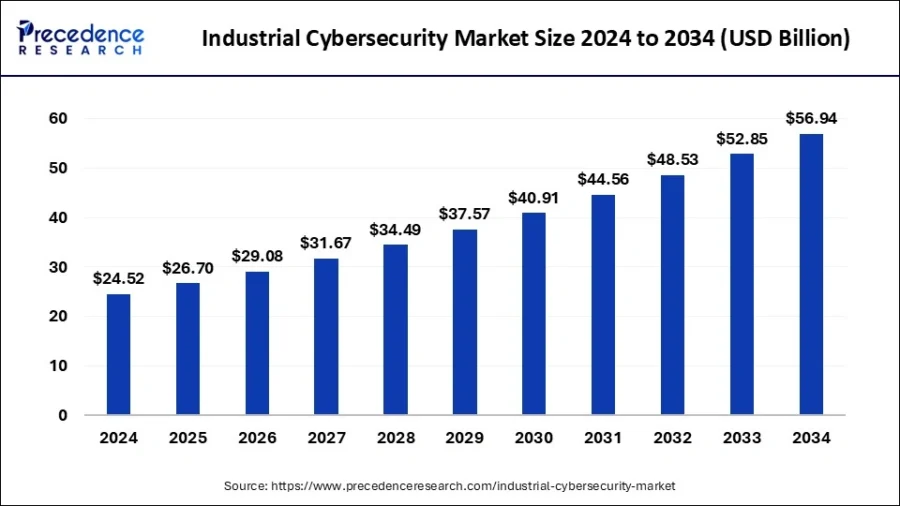
Credit: Precedence Resource
Zero trust architecture (ZTA) follows the principle of never trust, always verify. This offers continuous authentication for every access request. In asset management, ZTA blocks lateral network movement, verifies users and devices before granting access, and prevents unauthorized control of critical assets.
Cybersecurity asset management (CSAM) solutions also maintain an up-to-date inventory of all hardware, software, and network assets. They identify and mitigate vulnerabilities by ensuring full asset visibility. Tools like Lansweeper automate asset discovery and risk assessment to strengthen security.
OctoXLabs enables Cyber Asset Attack Surface Management
Turkish startup OctoXLabs offers an agentless asset attack surface management platform that maps and secures digital environments across server, client, cloud, and IoT infrastructures.
The platform utilizes API integrations to collect and consolidate cybersecurity inventory data, detect unmanaged assets, and close visibility gaps left by traditional agent-based tools. Additionally, it continuously tracks applications, licenses, users, and asset vulnerabilities, and links findings to a risk map.

The platform also automates responses through an integrated action center to streamline remediation in connected systems. Further, OctoXLabs combines asset discovery, monitoring, and response in one interface to increase visibility, improve cybersecurity, and lower risks.
Notus Cyber improves Centralized Cyber Asset Visibility
UK-based startup Notus Cyber builds a centralized cyber asset attack surface management platform. It unifies device, software, and configuration data from existing tools into an updated inventory.
Simultaneously, the platform integrates data sources to detect all digital assets, track lifecycle events, and uncover misconfigurations or vulnerabilities. It also applies risk-based prioritization to identify critical threats as well as automates policy enforcement and license compliance.
Additionally, the platform connects asset data and service desks to improve issue resolution and maintain operational alignment. The startup replaces manual snapshots with real-time intelligence to improve visibility, security posture, and remediation.
7. Asset Lifecycle Management
ALM enables organizations to reduce the total cost of ownership by optimizing asset utilization and maintenance schedules. Projections suggest that organizations improve capital efficiency by at least 5% by adopting structured ALM frameworks tailored to asset-intensive environments.
ALM systems also ensure compliance by recording asset maintenance activities, inspections, and certifications. They reduce the risk of non-compliance and support audit readiness.
Additionally, effective ALM solutions forecast asset maintenance needs and schedule timely interventions to reduce asset repair costs and prevent costly breakdowns.
These operational and compliance advantages make ALM a strategic priority across asset-intensive sectors, which drive its growing adoption worldwide.
Likewise, IoT sensors enable real-time asset monitoring and improve industrial operations. Edge computing also minimizes latency and enables instant decision-making on remote oil rigs.
Moreover, asset managers track sustainability metrics like energy use and emissions. They use tools that monitor carbon footprints and align asset operations with ESG standards.
Mobile and remote management tools further allow for real-time tracking and maintenance of assets, particularly in distributed work environments. EZOfficeInventory, for instance, provides mobile asset management capabilities that offer efficient operations.
BlueTally offers a Cloud-based Asset Management Platform
Norwegian startup BlueTally provides a centralized asset management platform that digitizes and automates the full lifecycle of physical and digital assets. It synchronizes asset data in real time by integrating with mobile device management systems (MDMs) like Intune, Jamf, and Kandji.
This enables asset management teams to track assets continuously from acquisition to retirement. Moreover, the platform eliminates spreadsheet-based inefficiencies by assigning assets to employees or locations and logging transactions with digital signatures. It also offers return deadlines through automated reminders.
BlueTally also enables operational control through custom permission levels, role-based access, and API-driven workflow automation. Its reporting tools deliver actionable insights on asset depreciation, warranties, and audit trails with one-click exports and advanced filters.
This way, the platform tracks accessories, components, and consumables while issuing low-stock alerts to avoid shortages.
Equipmeter develops an Asset Lifecycle Tracking and Management Platform
Estonian startup Equipmeter builds an asset lifecycle management platform that centralizes maintenance data to streamline operations and improve equipment reliability. It consolidates asset records, performance metrics, and maintenance history for organizations to track asset conditions and schedule preventive maintenance.
Moreover, the platform supports real-time work order management and technician access for reducing delays and manual documentation.

The platform provides customizable dashboards and KPI reporting tools that allow asset management teams to monitor performance trends and identify areas for improvement. Additionally, Equipmeter reduces asset downtime, improves workforce efficiency, and extends asset life by integrating maintenance planning with data-driven insights.
8. Remote Asset Management
Remotely managing assets delivers real-time visibility into physical asset performance and improves operational efficiency. Organizations continuously monitor assets, detect anomalies early, and address issues before they escalate into major problems.
Manufacturers implement RAM solutions and reduce equipment downtime by 20.1%, which demonstrates the impact on operational continuity.
Another compelling reason for implementing RAM is that it delivers substantial cost savings across business operations. By shifting from time-based to condition-based maintenance, companies eliminate unnecessary tasks, reduce associated costs, and extend asset lifespan. Industrial-focused asset management software reduces material costs by 19.4% and lowers inventory maintenance and repair expenses by 17.8%.
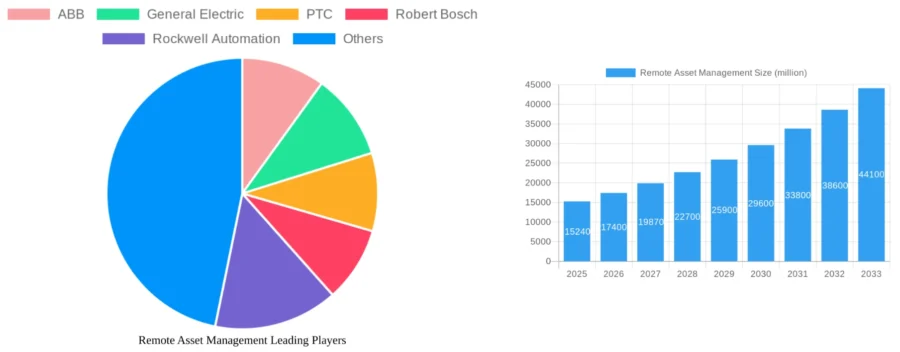
Credit: Data Insights Market
Geospatial tools track and manage assets based on location, which supports industries with distributed operations. For example, the Maharashtra government uses GPS-enabled platforms in its e-Panchanama project to document disaster-affected assets in real time.
Additionally, mobile asset management applications allow field technicians to access asset data, report issues, and perform maintenance tasks on the go. EZO AssetSonar provides mobile capabilities for asset tracking and management.
Predictive maintenance tools also analyze historical and real-time data from connected assets to forecast equipment failures. This allows organizations to schedule interventions remotely and avoid unexpected downtime. Vestas, for example, utilizes predictive maintenance to optimize wind turbine operations, reduce downtime, and maintenance costs.
Further, IoT sensors support remote asset management by monitoring asset conditions in real time. They enable predictive maintenance, reduce operational disruptions, and improve oversight across dispersed assets. For example, Maersk employs IoT sensors to monitor shipping containers globally and to improve supply chain transparency.
G2EMO Technologies enables Real-time Monitoring and Distributed Asset Optimization
UK-based startup G2EMO Technologies creates remote asset management solutions that monitor, diagnose, and control distributed infrastructures. The startup combines augmented reality (AR), IoT sensors, and data analytics to oversee diesel tanks, liquefied petroleum gas (LPG) containers, generators, fleets, and mobile equipment.
It also supports remote collaboration and troubleshooting through technologies like GOLDENEYE, while e-TANK and SYLO-FLEET SAP track inventory for domestic and industrial liquid commodities. Moreover, ROTO and EYEGAS detect leaks and provide continuous status updates to increase safety and resource efficiency in LPG systems.
GE-DATOMS enables businesses to monitor and maintain generator performance remotely. Additionally, WATCHTOWER aggregates data on asset movement, utilization, and condition to support operational planning.
Infraon offers a No-Code IT Asset Management (ITAM) Platform
US-based Infraon provides an integrated artificial intelligence for IT operations (AIOps) and ITAM platform. It centralizes monitoring, tracking, and optimization of IT and non-IT assets in distributed enterprise environments.
The platform automates discovery, tracks assets in real time, and manages their lifecycle to maintain full visibility over hardware, software, and endpoints. It also supports agent-based and agentless deployments, streamlines onboarding, and network scanning.
Additionally, Infraon verifies assets, tracks compliance, manages software licenses, and presents insights on depreciation, availability, and usage through built-in dashboards. The platform also eliminates operational inefficiencies by unifying data and automating workflows like procurement and fault reporting.
9. Predictive and Preventive Maintenance
Predictive maintenance solutions identify potential issues before asset failures. Asset-intensive organizations use machine learning to detect problems early and extend the service life of assets by an average of 30%.
Predictive maintenance also equips asset managers to collect and analyze precise asset data. IoT sensors calculate the mean time between failures (MTBF) and guide teams to schedule maintenance or replacement at a cost-effective point in the asset’s lifecycle.
Moreover, such solutions improve operational efficiency by proactively identifying and addressing potential equipment failures. It allows businesses to schedule maintenance at convenient times and reduces the risk of unexpected breakdowns that disrupt production.
The global predictive maintenance market size is projected to grow from USD 13.65 billion in 2025 to USD 70.73 billion by 2032, exhibiting a CAGR of 26.5%.
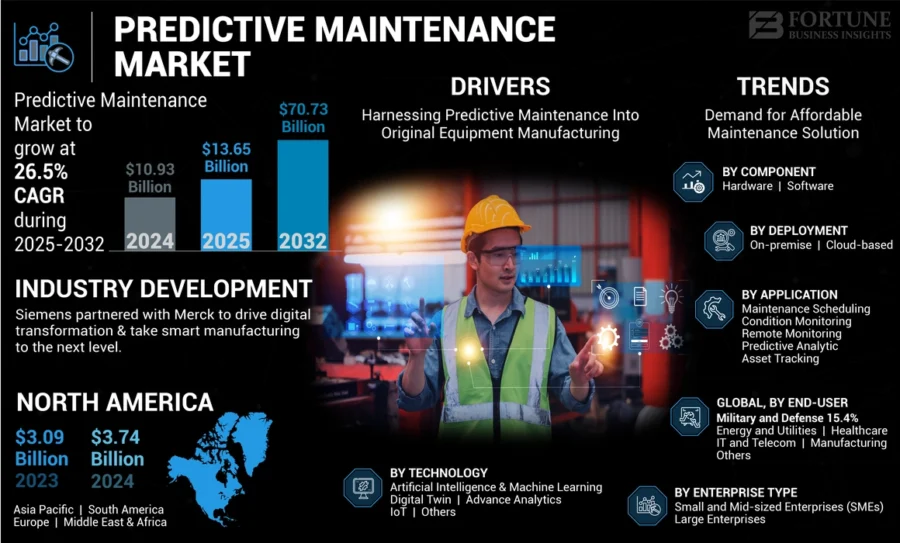
Credit: Fortune Business Insights
Further, cloud-based predictive maintenance systems centralize data storage and analytics for asset monitoring across global operations. For instance, KONE’s cloud-connected elevators use edge computing to process sensor data locally. It transmits critical insights to reduce latency and improve decision-making.
Cerev CMMS builds Smart Maintenance Automation Software
Malaysian startup Cerev CMMS develops a centralized asset management platform to automate maintenance operations and improve asset reliability. The startup digitizes asset records, schedules maintenance, and tracks work orders through a secure cloud-based system.
Additionally, the platform removes manual data entry by enabling real-time logging through QR code scanning and mobile app input, while its smart validation engine maintains data accuracy.
Tebe enables Precision Asset Monitoring and Management
Brazilian startup Tebe provides an industrial asset management solution. It utilizes precision sensors and AI-powered software to support predictive and preventive maintenance. The company deploys the Tebe NXG sensor to monitor vibration and temperature levels of industrial equipment and transmits real-time data through a gateway to the cloud.
The IoTebe platform then processes this data with machine learning to generate automated diagnostics and condition assessments. This enables businesses to detect faults early and avoid unplanned downtime.
Additionally, the platform issues real-time alerts when it detects anomalies for teams to schedule corrective actions and align maintenance with production workflows. Moreover, the sensor simplifies installation and operates reliably in demanding industrial environments.
Consequently, the platform maximizes asset availability, reduces intervention costs, and maintains production continuity in sectors like sugar and alcohol.
10. Advanced Robotics
Robots replace human workers in dangerous settings like chemical plants to mitigate risks. They work continuously as well as deliver consistent monitoring and maintenance.
Cost optimization also drives the adoption of advanced robotics in industrial asset management. A BCG analysis shows that deploying advanced robots reduces conversion costs by up to 15%. When companies combine robotics with complementary technologies and process improvements, they achieve savings of up to 40%.
The persistent global labor shortage, particularly acute in developed economies with aging populations, further creates a demand for robotics solutions. Projections indicate a shortfall of 11 million workers by 2040 in Japan.
The global advanced robotics market size is predicted to increase from USD 53.74 billion in 2025 to approximately USD 280.01 billion by 2034, expanding at a CAGR of 20.13% from 2025 to 2034.
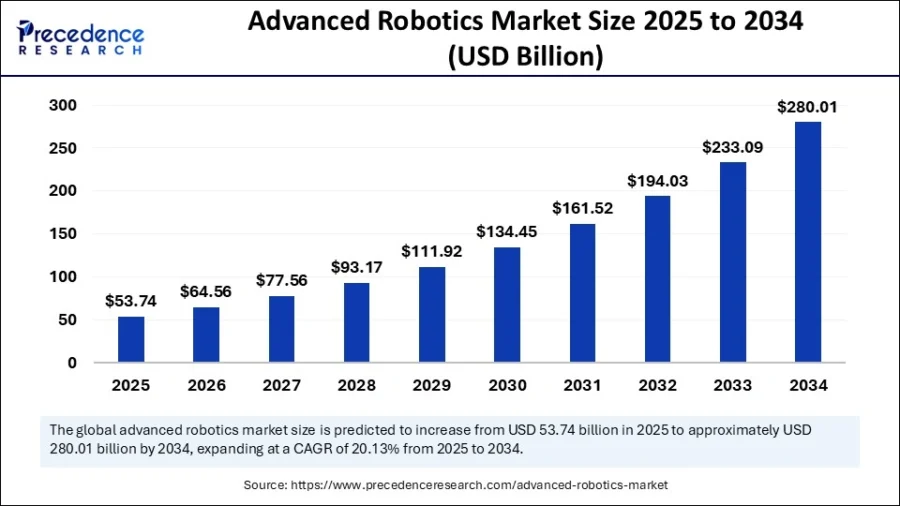
Credit: Precedence Research
Further, autonomous mobile robots (AMRs) move through industrial facilities to transport materials, track assets, and support maintenance tasks. This improves asset utilization and reduces manual workload. For example, Mobile Industrial Robots (MiR) offers AMRs that streamline asset handling and enhance operational efficiency.
Moreover, robotics-as-a-service (RaaS) reduces upfront capital expenditure and enables flexible deployment.
Sunnybotics offers a Robotics and AI Platform for Solar Operations and Maintenance
US-based startup Sunnybotics develops an integrated robotics and AI-driven platform that operates and maintains photovoltaic (PV) solar assets. It collects project-specific data from customers, conducts technical assessments, and deploys robotic systems to clean panels and gather data in solar installations.
Additionally, the platform compiles detailed reports that present performance metrics, soiling levels, and recommended maintenance timelines. It improves performance and conducts on-demand operations through automation that reduces manual intervention and extends asset lifespan. This way, the platform optimizes energy output, minimizes costs, and streamlines solar asset management for utility-scale and distributed operators.
Crest Robotics provides Robotic Automation for Industrial Task Assistance
Australian startup Crest Robotics builds robotic systems that automate high-risk, labor-intensive tasks across critical infrastructure to improve asset management. The startup designs and deploys sector-specific robots that perform repetitive tool-based labor for energy and construction maintenance. Its autonomous climbing robots inspect confined spaces in ship hulls.
These robots reduce human exposure to hazardous environments and continuously collect operational data to support real-time diagnostics and long-term maintenance planning. The startup also integrates mobile manipulation and additive manufacturing into logistics and space construction.
Discover all Asset Management Industry Trends, Technologies & Startups
Emerging technologies are improving asset management and turning it into an intelligent and interconnected discipline. Digital twins are serving as real-time virtual counterparts of physical assets. This will allow teams to simulate performance, run predictive analyses, and make informed decisions across the asset lifecycle.
Blockchain will also secure asset tracking across supply chains by preserving data integrity and building trust, while additive manufacturing is enabling rapid prototyping and on-demand production. They reduce downtime and inventory costs by quickly producing complex parts. This enables instant analysis and faster operational responses.
The Asset Management Trends & Startups outlined in this report only scratch the surface of trends that we identified during our data-driven innovation & startup scouting process. Identifying new opportunities & emerging technologies to implement into your business goes a long way in gaining a competitive advantage.



